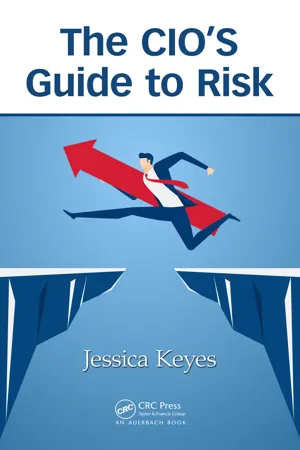
- 212 pages
- English
- ePUB (mobile friendly)
- Available on iOS & Android
The CIO's Guide to Risk
About This Book
In an age of globalization, widely distributed systems, and rapidly advancing technological change, IT professionals and their managers must understand that risk is ever present. The key to project success is to identify risk and subsequently deal with it.
The CIO's Guide to Risk addresses the many faces of risk, whether it be in systems development, adoption of bleeding edge tech, the push for innovation, and even the march toward all things social media. Risk management planning, risk identification, qualitative and quantitative risk analysis, contingency planning, and risk monitoring and control are all addressed on a macro as well as micro level.
The book begins with a big-picture view of analyzing technology trends to evaluate risk. It shows how to conceptualize trends, analyze their effect on infrastructure, develop metrics to measure success, and assess risk in adapting new technology. The book takes an in-depth look at project-related risks. It explains the fundamentals of project management and how project management relates to systems development and technology implementation. Techniques for analyzing project risk include brainstorming, the Delphi technique, assumption analysis, and decision analysis. Metrics to track and control project risks include the Balance Scorecard, project monitoring and reporting, and business and technology metrics. The book also takes an in-depth look at the role of knowledge management and innovation management in identifying, assessing, and managing risk.
The book concludes with an executive's guide to the legal and privacy issues related to risk management, as well overviews of risks associated with social media and mobile environments. With its checklists, templates, and worksheets, the book is an indispensable reference on risk and information technology.
Frequently asked questions
Information
1Analyzing Technology Trends to Evaluate Risk
Technology Trend Analysis
- Internal information gathering
- Gather internal organizational information, mission statement, strategic goals, tactical goals, and operational goals
- Distribute a survey to key decision makers and align expectations for primary goals with technology trends
- Gather information on marketing and advertising strategies, and identify short- and long-term goals
- Understand branding strategy including the desired perception, message, and tone
- Gather qualitative data on customers and customer service
- External information gathering
- Research your industry using traditional research methods, the library, online searches, paid research organization, etc.
- Research industry-specific publications, newsgroups associations, organizations, white papers, etc.
- Identify primary and secondary competition
- Identify main differentiators from competition
- Technology information gathering
- Gather quantitative data on existing infrastructure; use logs to analyze traffic patterns and identify trends
- Conduct a technology audit to determine how effective the current infrastructure is at meeting the overall goals of the organization
- Define the extent of infrastructure upgrades required to support the new technology
- Define the primary goal that the new technology will help the organization achieve
- Create scenarios of what the future would look like if the new technology were implemented
- What business objective will the technology impact?
- Can the business objective be tied back to a strategic, tactical, or operational goal?
- What impact will the new technology have on the existing infrastructure?
- Does the organization have internal expertise to support the new technology?
- Increase market share
- Increase customer satisfaction
- New product or service development
- Compete more effectively
- Decrease demand for customer service
- Create alliances or partnerships
- Streamline supply chain
- Create a scalable infrastructure for growth
Conceptualizing Applicability of Emerging Trends
Table of contents
- Cover
- Half Title Page
- Title Page
- Copyright Page
- Dedication
- Contents
- Acknowledgments
- Author
- Introduction
- Chapter 1 Analyzing Technology Trends to Evaluate Risk
- Chapter 2 Information Technology Project Risk
- Chapter 3 Risk Analysis Techniques
- Chapter 4 Auditing Knowledge Management to Reduce Risk
- Chapter 5 Innovation Management to Reduce Risk
- Chapter 6 Performance Measurement and Management for Reduced Risk
- Chapter 7 Information Technology Project Tracking and Control
- Chapter 8 Fundamentals of Information Technology Project Management
- Chapter 9 Project Critical Success Factors
- Chapter 10 Legal, Privacy, and Security Risk
- Chapter 11 Assessment and Mitigation of Risks in a Bring Your Own Device (BYOD) Environment
- Chapter 12 Social Media Risk
- Index